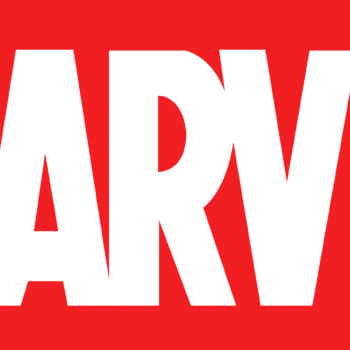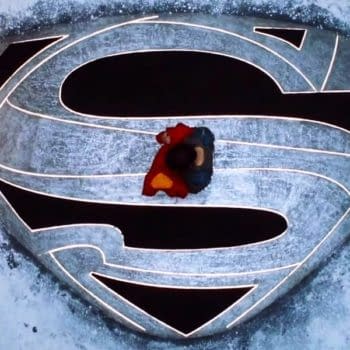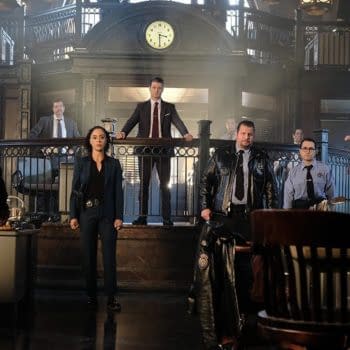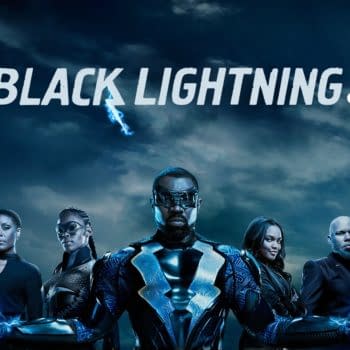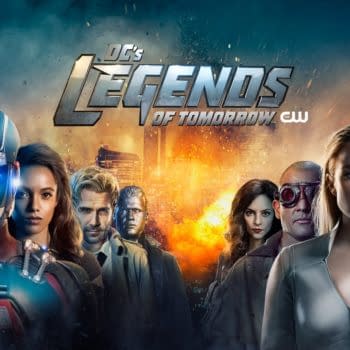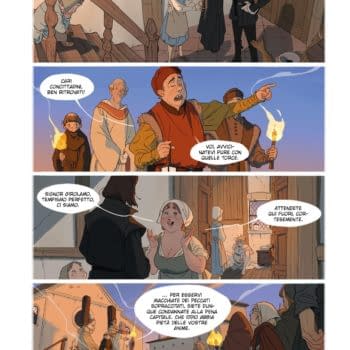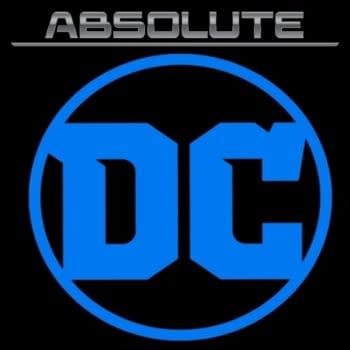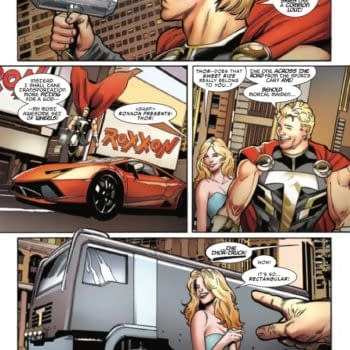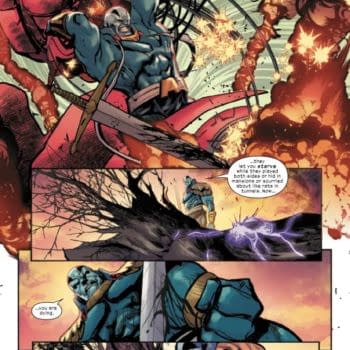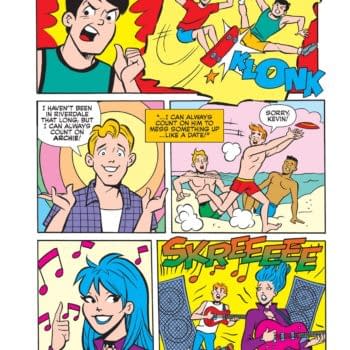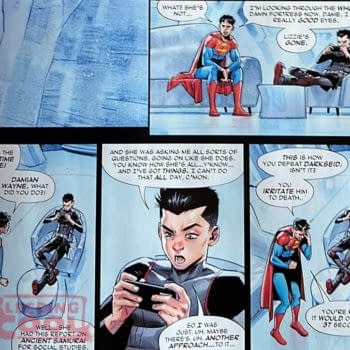Posted in: Comics | Tagged: Comics, dynamite, entertainment, Erik Mona, pathfinder, Worldscape
Writer's Commentary – Erik Mona On Pathfinder: Worldscape #6
Dynamite has sent us a new writer's commentary featuring Erik Mona talking about Pathfinder: Worldscape #6. Cover by Elliot Fernandez and interiors by Jonathan Lau.
Pathfinder Worldscape, Dynamite's spectacular sword-and-sorcery superstar crossover, wraps up this week with Red Sonja, John Carter, the Pathfinders, and a host of jungle-themed comics heroes squaring off against the arch-wizard Kulan Gath and his army of gorilla scum culled from three worlds! At long last we finally meet Tarzan, King of the Apes, as the surviving heroes and villains duke it out in the headquarters of the Council of Jungle Kings!
A few years ago, when I was kicking around the idea that would become Pathfinder Worldscape, Dynamite's president, Nick Barrucci, suggested that I include some public domain fantasy comics characters among the licensed heroes like Tarzan and Red Sonja. Knowing that Tarzan was to appear in the series, I first turned to the jungle comics of the 1940s and 1950s in an attempt to reclaim a few lost souls. Many of these folks had not appeared in comics in more than 60 years, an absence easily explained by an abduction into the Worldscape prison dimension.
There are a lot of regrettable political elements in these old jungle comics, but there's a lot to like, too—magic, monsters, hand-to-hand combat, and more thematic elements popular with sword and sorcery readers. One of my favorite characters of this bunch, Frank Frazetta's Thun'da, provided a lot of inspiration for the Worldscape in general, and for the use of jungle-themed characters within it.
Although post-Frazetta issues of Thun'da fit the traditional "white man saves Africa" motif popularized by Tarzan himself, Frazetta's early Thun'da stories maroon his hero in a time-lost valley filled with cave men and dinosaurs, rather than stereotypical primitive African tribesmen. The stories thus provide fun jungle adventure without some of the racism so common to comics of the era. I also appreciated the idea of a "land out of time" like Thun'da's Dawn Lands, which I essentially incorporated wholesale into the Worldscape milieu.
That decision also gave me access to Thun'da's supporting cast, including the warrior queen Pha, the druidic and brutal Cave Girl (who got her own comic for a spell), and a little-known African hero called King Rex, a mighty chieftain with an equally mighty magic axe. King Rex was one of my favorite discoveries during the lengthy Worldscape research process—a genuine black African Golden Age comics hero who was portrayed heroically and sympathetically in his original run. It's crazy how rare non-white heroes are in old-time jungle comics. It's even rare for native Africans to have speaking parts at all. Like the trees and the rhinos, they're just background signifiers of "Africanness" that play out behind white people talking to each other and solving jungle problems all by themselves.
King Rex, Cave Girl, Pha, and Thun'da (and his pet smilodon Sabre) are all cool characters with a ton of potential. I'd love to write a whole series about these guys somewhere down the line.
For now, though, these characters are around to serve the greater narrative of Pathfinder Worldscape, and to provide a bit of context for Tarzan and his role in that narrative. From the very start, I knew I wanted to delay Tarzan's entry into the series, to make it really climactic. I love the Pathfinder heroes, and all, and of course it's an honor to write a character with such a rich comics pedigree as Red Sonja, but when it comes to archetypal heroes, Tarzan is really the biggest superstar in the series. Even John Carter himself doesn't quite reach Lord Greystoke's level of cultural significance. I wanted his eventual appearance to really pack a punch.
To that end, all of these other jungle characters are there to build up the anticipation for Tarzan's eventual arrival and to emphasize the mystery of where he's been all this time.
Four other jungle comics characters bear a bit of further discussion before I jump into a page-by-page breakdown of Pathfinder Worldscape #6.
Empress Camilla: One of the chief villains of Pathfinder Worldscape came from 1940's Jungle Comics #1, a multi-hero book packed with lots of stories every issue, some of them charming, some of them pointless, and some of them frankly pretty dire. Camilla, for me, fits into the first category. The version trapped in the Worldscape is from her first few issues—an immortal, thoroughly evil tyrant who keeps herself young by bathing in magical waters of eternal youth. Merisiel appeared to have killed Camilla in the previous issue, but if her Golden Age appearances are anything to go by, a little dip in a magical pool ought to clear that right up. Camilla took on a few different appearances and demeanors over the years, finally transforming into a blonde "jungle girl" archetype with little to differentiate herself from a horde of Sheena clones. In the middle there she was a heroic sword-and-sorcery swordwoman. If for whatever reason Dynamite is ever crazy enough to let me write another comic set in the Worldscape, I'd love to explore this side of Camilla's character.
Fantomah: I've already gushed about the weird, wonderful character Fantomah in previous Worldscape writer's commentaries, as well as on my blog at erikmona.com. Simply put, Fletcher Hanks's creation is one of the most original characters to come out of comics, period, and certainly the strangest to emerge from the pages of Jungle Comics. Like so many other interesting creations of that book, Fantomah was eventually given to less inspired writers and artists than Fletcher Hanks, and she too became an unremarkable jungle girl clone. Hanks gave Fantomah (and really all of his characters) omnipotent powers that essentially qualified them as gods, so that's the way I used her in this series. Again, I enjoy this character so much I'd write her again in an instant, if given the opportunity.
Tabu: The Wizard of the Jungle, is another character from Jungle Comics. His first appearance was illustrated (and, I presume, written) by Fletcher Hanks, but the character soon fell to other artists and eventually disappeared completely. He has that absurd Fletcher Hanks magic about him, so I absolutely wanted to incorporate him into the issue. The "Jungle Magic" referred to in the issue's title speaks mostly of Fantomah, but good old Tabu is a part of it, too.
Wambi: Little Wambi never changed too much over the years in Jungle Comics, but he was a ubiquitous presence throughout its run, and even got his own comic for a while. Wambi is quite like Cave Girl in that he speaks to animals and hangs around with a bunch of them, but he's not quite the fighter she is. His stories seemed a bit more aimed at children than those of, say, Fantomah. I imagine the idea was for kids to identify with the little guy. I like his look, his elephant, and his generally positive attitude.
Enough preamble, let's get to the issue itself!
PAGE 1
The issue opens with a quiet moment between Wambi and Tabu as they stand guard outside the compound of the Council of Jungle Kings. Wambi's elephant, Tawn, is from the original comics—the beast is one of Wambi's most frequent guest stars. It seemed only fitting that he would be pulled into the Worldscape along with his young friend. Thun'da emerges to question Tabu's "Seventh Sense" (the source of some of his bizarre powers, per the original Fletcher Hanks strip). He knows that the oncoming thunder is not to be feared.
PAGES 2-3
The "thunder" turns out to be the oncoming party of assembled heroes, who have ridden-hard on eight-legged thoats to rush to the defense of the Jungle Kings and the magic Crown guarded by their First King, Tarzan. The heroes have come from the city of Shareen (another pick-up from Thun'da's Dawn Lands), and they're expecting a big fight when they arrive. After all, Kulan Gath and his surviving associates (including the Pathfinder rogue, Merisiel) left in the direction of the jungle in their airship the previous issue. Thoats, of course, are the preferred riding beast of Barsoom, and originally appeared in "A Princess of Mars," the first John Carter story. Their appearance here is in keeping with their previous presentations in Dynamite's Warlord of Mars and Dejah Thoris titles.
PAGE 4
Thun'da and Pha are lovers, so naturally they greet each other with a warm embrace. In the background, Tars Tarkas reunites with Sabre, his old companion from Pathfinder Worldscape #2. John Carter reports on Camilla's fate, and that the Scepter has fallen into the hands of Kulan Gath. Wambi's parrot, Maggo, is a named character from an old Wambi story from the 40s. It was certainly fun scanning 50 issues of Wambi comics for a parrot's name. By the end of the page, Thun'da and Tars Tarkas realize that Gath's airship wasn't headed toward the compound of the Jungle Kings, but instead to the city of Kho, site of Ruthazek's gathering ape army from the final pages of Pathfinder Worldscape #2.
PAGE 5
You'd think I'd get used to it after six issues, but Jonathan Lau really shines with these group scenes. I can't imagine he knew he was signing up for a series with so many characters and so much art reference when he joined the project, but I am so glad that he did. He handles all of these characters wonderfully. Best of all, his able pen makes all of them look like they inhabit the same world. Some of these guys, like Wambi and Tabu, have literally never looked so good. I'll miss working with Jonathan, and hope our comics paths cross again in the future!
PAGE 6
Note the broken and overgrown Pillars of Nex summoning obelisks incorporated into the gateway entrance to the Jungle Kings' kraal. They are meant to represent the Kings' struggle against the insidious magic of the prison-plane, as well as their acceptance of their fate. They also look cool.
After five issues of no Tarzan, I figured some readers were getting fed up with his absence. Who better to advocate that position than Red Sonja (in her traditional third-person voice, no less)? Sonja is a woman of action, and sitting in a cabin reliving past victories doesn't strike her as a very effective means of protecting the jungle.
As she approaches Tarzan's cabin, she passes Cave Girl and King Rex, who attempt to greet her warmly. When King Rex tells Sonja "It will be an honor to fight at your side," and Cave Girl says "It's so good to see you again," they're both referring to a specific adventure they shared in the past.
Given all the research and all the big ideas I've had about the Council of Jungle Kings over the past two years, and given that King Rex and Cave Girl are two of my favorite characters in the group, it's sad that their role in this issue amounts to these two panels, and a few bits of background action later in the issue. The truth is that Pathfinder Worldscape is a huge story with a roster of about 40 characters, and as the series kept chugging along, I wasn't able to do everything I wanted to do—some stuff had to be cut.
Happily, Dynamite added four Pathfinder Worldscape One-Shots to the schedule as part of a recent Humble Bundle effort. One of those issues features a previous adventure of Sonja, King Rex, and Cave Girl, which gave me the opportunity to delve a bit more deeply into these interesting characters. These issues will shortly be available on paizo.com, so if you want more Worldscape action, look out for four prequel stories coming your way soon. (These Humble Bundle issues will not be available in stores, though they will be collected in a later hardcover.)
PAGE 7
The illustration of Tarzan's cabin strongly resembles its original appearance in Dynamite's first Lord of the Jungle arc, which retells the Tarzan origin story. Red Sonja referring to Thun'da's allies as "dogs" is in character. Calling people—even friends—dogs is one of her go-to insults.
Later, as Red Sonja enumerates Kulan Gath's accomplishments, she quotes the Robert E. Howard story "The Phoenix on the Sword" when referring to the oceans drinking Atlantis, a line that also shows up in the opening of the Conan the Barbarian movie. Kulan Gath's various nick-names here are from early Dynamite Red Sonja issues.
PAGES 8-9
Ruthazek's ape army invades the kraal of the Jungle Kings in a brilliant panel from Jonathan Lau. Tabu uses his jungle magic to transform one of the invading apes into a plant creature (a trick from one of his original Jungle Comics stories).
Note that as Kulan Gath says "our trap is set" in the final panel of this sequence we can see Fantomah's skull-like visage peeking out from the distant treeline. Gath is right that a trap has been set, but it isn't the one he's been planning for.
PAGE 10
The Pathfinders do their best against Ruthazek's apes while the black Martian Phondari fires a volley of radium pistol shots at John Carter and Tars Tarkas. Phondari comes from Dynamite's Dejah Thoris comics, so I couldn't resist her mentioning her foe when confronted by her husband.
PAGE 11
This was one of the first sequences I imagined when I got the job to write the Worldscape comic. All of the jungle heroes with animal rallying cries get a chance to shine here, each of them chanting a legitimate cry from their original 1940s and 1950s comic appearances.
PAGE 12
Of course, the reason all of these characters even have a call is because they're all to some degree knock-offs of Tarzan, who has the most famous jungle call of all—the victory cry of the bull ape. The version of the cry he yells out here is the authentic Dynamite Tarzan cry. That said, I've got a few problems with it, because it seems too short to me to be authentic and I can't get it to work itself out to sound like the Johnny Wiessmuller version that made the call so famous. I was unable to turn up a different, more official transliteration of the cry, but I did find an official patent application for the noise. One thing everyone seems to agree on is that the cry is a palindrome. I'd have preferred that the official Dynamite version read the same backward and forward to better match this fact, but you can't always get what you want.
Incidentally, the sweater-clad ape running away in the bottom right-hand corner of panel 4 at the bottom of the page is Boorg, an early Thun'da villain. Had I had more space, this guy would have been Ruthazek's lieutenant. As it is, he gets a little cameo.
PAGE 13
Tarzan is well and truly in the fight with this sequence, and he's more than holding his own. We see him wearing the magical Crown so coveted by Kulan Gath, but he's otherwise very much the Dynamite version of the King of the Apes, only with a leopard-skin loincloth added by Jonathan Lau. I strongly suspect that Jonathan was inspired by the Frank Frazetta reference I sent him for one of the alternate covers of this issue, in which Tarzan dangles from a tree branch while observing the Pathfinder heroes exploring the jungle below him. Tarzan wears a similar leopard-skin loincloth in that image, as well.
I chose that image for one of the covers because I noticed that the pose had been lifted in about a half-dozen (at least) panels of various jungle comics. Thun'da himself strikes the pose a few times (in the first Frazetta issue and later when the series moved to artist Bob Powell), but I've also seen it swiped in the Kaanga lead feature of Jungle Comics.
I briefly considered featuring the blonde-haired Kaanga among the Council of Jungle Kings, but his stories struck me as particularly racist and I already had too many characters, so he was an early casualty, despite having a jungle cry that would have fit well into the previous sequence.
PAGE 14
This sequence, in which Merisiel takes advantage of Tarzan's rage to swipe the Crown off his brow, works fine as presented, but perhaps not as well as it was originally intended. One of the most interesting elements of Edgar Rice Burroughs's original version of Tarzan is that he has a big red scar running from the top of his head across part of his forehead, the memento of a vicious early battle against a bull ape who nearly tore his scalp from his skull. In the books, when Tarzan gets angry, the scar blazes red. Tarzan, at least in the first book, is somewhat more like a Pathfinder RPG barbarian than anything else, prone as he is to fits of scar-brightening rage.
The only trouble is, the scar has seldom played into graphic depictions of the character, and near as I can tell it's not really a part of the Dynamite version of Tarzan at all. I tried to sneak it in anyway in my script. The exact moment Merisiel is trying to time is the moment Tarzan's rage-scar turns deep red.
I suspect Jonathan had no idea what I was talking about. There's a hint of a scar under Tarzan's eye here (not in the right place, but I'll take it), and Omi Remalante's coloring of that scar—as well as making Tarzan's eyes flash red—seems to do the trick.
Not everything needs to be an Easter egg, Erik!
PAGE 15
Kulan Gath's moment of victory, in which he touches the Scepter and Crown together with an unsatisfying "tink, tink, tink," is another moment that gelled very early on, and appeared in the very first draft of the series outline. This page lays out Gath's master plan very clearly, in case the sub-text of the previous five issues was too subtle for some people.
PAGE 16
And now it's Merisiel's turn to reveal her secrets, and the true nature of the deal she brokered with Fantomah to escape the Worldscape the first time. She's been a lure to get Kulan Gath to a part of the jungle he hasn't already tainted so that Fantomah can use her jungle magic against him.
PAGE 17
I felt so bad for sidelining Tarzan for so much of this series that I had to give him a solid punch to the villain's face before things wrapped up. Red Sonja's reference to getting "so, so sick" of Kulan Gath's voice is a bit of a reference to the shallow nature of Red Sonja's rogue's gallery. Unbeknownst to me, Amy Chu's current Red Sonja run—which began at about the same time as Worldscape—ALSO uses Kulan Gath as the arch foe. When it came out that I was using him in this series, some stalwart Red Sonja fans on the Dynamite message boards complained about his ubiquity, and I see their point. I mean, not enough to NOT use Kulan Gath, but I put this line in there in part to echo the sentiment of those fans. If THEY are getting tired of Kulan Gath, I assume Red Sonja herself is even more over the guy.
PAGE 18
Tarzan punches Kulan Gath in the face. Red Sonja cuts off his hand. And finally, John Carter shoots him in the head with a radium pistol. All three major co-stars of the series get at least one good lick in on the villain before Fantomah destroys him completely (or at least as completely as you can ever destroy Kulan Gath). Her line "You shall meet a jungle fate" is directly lifted from Fletcher Hanks, who makes all of his characters talk in the same grandiose fashion.
PAGE 19
Tarzan says goodbye to the Council of Jungle Kings, who pledge to defend the Worldscape in his place. It's too bad I put so many words in Thun'da's mouth in this sequence. Jonathan's panel of the assembled Council looks spectacular. Poor King Rex and Cave Girl. They deserved better than to be covered up by a word balloon.
PAGE 20
After Tarzan returns to Earth, the other heroes accept Thun'da's invitation to feast. Red Sonja and Valeros plan to settle up some unfinished business, and John Carter pledges to teach the Jungle Kings how to use their new airship, which he has appropriated from Phondari.
PAGE 21
Merisiel and Kyra finally have that conversation they've been putting off, which brings resolution to their character arcs for the series. Just as you're about to wonder how important that resolution will be once they return to Golarion and forget their Worldscape adventures, along comes Fantomah to tell them that at least Merisiel is destined to return to the Worldscape, and that—somehow—some time in the future, Fantomah herself will assist Merisiel on her world.
PAGE 22
And then we're back where the whole Worldscape adventure started, in the sewers below the city of Magnimar on the world of Golarion. The Pathfinders' old enemy, the veiled master Thulgroon, is nowhere to be seen (having slipped away during the heroes' brief absence), so the group decides to head back to their home tavern. As Merisiel walks by, we see a familiar skull visage in her forehead gem—the exact spot touched by Fantomah in the previous sequence!
And that's it for Pathfinder Worldscape #6, and for the mainline Pathfinder Worldscape series itself. As I mentioned above, Dynamite will shortly publish four special Worldscape issues as part of a recent Humble Bundle effort. These issues will not be available in stores, but a limited number ARE slated to appear for sale on paizo.com. Follow me on Twitter @erikmona, and I'll be sure to post a link when they go live.
The one-shots focus on prequel stories. A Lord of the Jungle special by author Christopher Paul Carey reveals Tarzan's first adventure in the Worldscape, in which he goes up against serpent-men and the legendary twins Romulus and Remus in an effort to rescue his old friend La of Ancient Opar. A Pathfinder One-Shot by Pathfinder comics co-author James L. Sutter presents a previously unrevealed story of the magus Seltyiel and a small group of goblins, who face the vampiric duo of Vlad the Impaler and Elizabeth Bathory. I wrote a Red Sonja special in which she teams up with King Rex and Cave Girl (remember them?) to battle white Martian Holy Therns in a ruined temple of the death goddess Issus, as well as a Warlord of Mars One-Shot in which John Carter encounters a timelost warrior from his own past in the American Civil War.
It's been a delight peeling back the pages of Pathfinder Worldscape with you in the course of these Writer Commentaries. I hope to one day get a chance to write more comics set in the Worldscape, and if that ever happens, I look forward to revealing to you how deep and obsessive my nerdiness for this stuff can go. And if you've managed to make it this far, I know you'll be right there with me.
Cheers!








